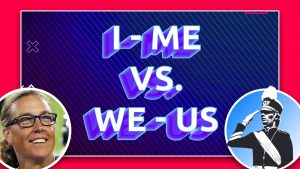
It is the time-of-year when we can all use a booster-shot of ENTHUSIASM to guarantee the ongoing positive momentum of our band members and – most importantly – of ourselves.
With several weeks of marching band under-our-belts, it is vitally important for drum majors to focus their efforts on SOLUTIONS rather than PROBLEMS.
Herein lies the ultimate test of your leadership effectiveness. Above all, YOU must serve as the exemplary ROLE MODEL for all members of your band. We’re coming to the end of the marching season, so the goal is to complete the journey at the peak-of-excellence.
Where are you presently centering your leadership efforts-and-energies?
Elements of a Solution-Driven Leader (SDL)
A gifted leader will seek an objective/solution and then begin to move in the direction of the given goal rather than dwelling on the current status and all the reasons the organization cannot reach the objective.
This comes about by using a clear and concise blueprint of a solution-driven vs. a problem-driven plan of action.
Spotlight strengths & emphasize what’s working
The solution-driven leader (SDL) spotlights the strengths of the followers and emphasizes what is already working.
Instead of quickly pointing out everything that is wrong, ineffective, inefficient, and preventing forward progress, the leader will first make a point to recognize the various aspects of the project (including the people) that give it credibility and make it worth the follower’s investment of time and energy.
The benefit package must be obvious, or there will be no ownership of responsibility by the followers and, thus, no group cooperation and lackluster participation.
Encourage communication & involvement
The solution-driven leader sets a stage of open communication and personal involvement. Too often we look for those we can blame for the present predicaments; such behavior can garner initial agreement and emotional approval, but it has nothing to do with solving the problem.
It is, at best, a momentary “feel good” and rarely serves the group or the leader.
The SDL will create a safe, open forum of communication with everyone and begin to listen to any and all suggestions in an effort to attain a better outcome.
In turn, everyone begins to become more involved in the implementation of a plan that reflects the group’s thoughts and ideas.
Keep everyone focused on the goal
The solution-driven leader keeps everyone focused on the goal. We often sabotage ourselves by dwelling on the opposite of what we want. Noted psychologist/philosopher, Abraham Maslow, said, “The mind will lead us in the direction of its dominant thought.”
If we spend our time thinking about why something will not work, we are leading ourselves to a predictable failure. A solution-driven leader will continue to communicate the desired goal to the members of the group; what the mind can conceive, the person can achieve.
We must picture high-level achievement in our minds at all times and be realistic in the assessment of what it will take to reach the goal.
This is one of the fundamental responsibilities of every SDL; focus the energy of the followers on the anticipated results.
Create energy and enthusiasm
The best way a leader can create energy and enthusiasm for a group is to model positive energy and sincere enthusiasm. This does not necessarily mean assuming the role of a cheerleader or extending shallow, ingenuine compliments.
It merely means demonstrating a genuine care for the people, the goal, and the welfare of everyone involved. A lethargic, negative leader will drain energy from any group, and he/she will amplify the problems facing the organization; on the other hand, an enthusiastic, positive leader will infuse the group with the needed energy to move forward and discover the endless possibilities available as a result of group cooperation.
Understand the secret to all leadership
The solution-driven leader understands the secret to all leadership, the one aspect over which he/she has complete control in every situation: the ability to choose one’s attitude at every moment of every day.
Create an atmosphere of problem-solving
The solution-driven leader creates an atmosphere conducive to effective and efficient problem-solving while giving continuous renewal to everyone involved. Being a leader does not mean “having all the answers.”
Young leaders often think they are responsible for every solution, answer, and resolution; such logic can result in frustration, confusion, and even delusion. A perceptive and effective SDL will encourage an ongoing exchange of helpful ideas from those who are part of the group.
Every suggestion will be met with genuine appreciation, and the communication will be used as an opportunity to confirm the value of the person involved. (If we inadvertently or purposefully reject someone’s suggestions, we stifle his/her creativity and create a barrier for further communication.)
Maintaining an open, honest, safe environment for group problem-solving is seen by many as the most important contribution of any solution-driven leader.
Enjoy this wonderful introspective bit-of-wisdom:
I Went on a Search to Become a Leader
I went on a search to become a leader. I searched high and low.
I spoke with authority; people listened. But alas, there was one who was wiser than I, and they followed that individual.
I sought to inspire confidence, but the crowd responded, “Why should I trust you?” I postured, and I assumed that look of leadership with a countenance that flowed with confidence and pride, but many passed me by and never noticed my air of elegance.
I ran ahead of the others, pointed the way to new heights. I demonstrated that I knew the route to greatness. And then I looked back, and I was alone.
“What shall I do?” I queried. “I’ve tried hard and used all that I know.” And I sat down and pondered long.
And then, I listened to the voices around me. And I heard what the group was trying to accomplish. I rolled up my sleeves and joined in the work.As we worked, I asked, “Are we all together in what we want to do and how to get the job done?” And we thought together, and we fought together, and we struggled towards our goal.
I found myself encouraging the fainthearted. I sought ideas of those too shy to speak out. I taught those who had little skill. I praised those who worked hard. When out task was completed, one of the group turned to me and said, “This would not have been done but for your leadership.”
At first, I said, “I didn’t lead. I just worked like the rest.” And then I understood, leadership is not a goal. It’s a way to reaching a goal.
I led best when I help others to go where we’ve decided to go. I led best when I help others to use themselves creatively. I led best when I forget about myself as leader and focused on my group…their needs and their goals.
To lead is to serve…to give…to achieve together.





